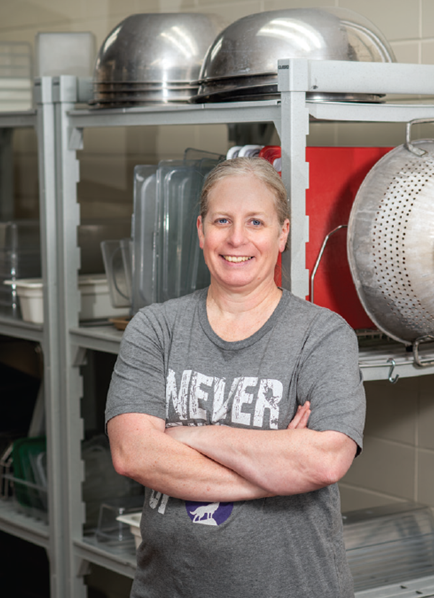School food service professionals deliver on state’s popular free school meals program
By Brenda Ortega
MEA Voice Editor

The professionals entrusted with delivering healthy, delicious food to hundreds of thousands of students in school cafeterias across Michigan say they’re serving more kids than ever as part of the state’s one-year trial of universal free school meals – and rising to the challenge with skill, focus and teamwork.
In approaching a new role as lead cook at Wyoming Junior High in Wyoming Public Schools, MEA member Delee Bruining has called on all of her experience in food service: four years as lead cook at a summer camp. Seven years working at an elementary school in the district.
To connect more kids with high-quality food and time to eat, Bruining revamped the kitchen’s structure and works to ensure all staff are cross-trained and feel heard and valued. “We’re really functioning and flowing as a kitchen, and I’m pretty proud of this staff for going the extra mile,” she said.
Dozens more kids per day have come through food lines this year in Wyoming, south of Grand Rapids, even though the district had offered universal free school meals before. Awareness seems higher, and perhaps stigma surrounding free meals has lessened since Gov. Gretchen Whitmer signed the Michigan School Meals program, Bruining said.
The program gives preK-12 public schools that participate in the U.S. Department of Agriculture School Nutrition Programs the option of offering one free breakfast and lunch for every student.
More than 850,000 of the state’s schoolchildren are eating school lunches this year, and more than 474,000 are eating breakfast there also, according to the Michigan Department of Education (MDE). On average statewide, 74,000 more students eat breakfast daily – a 23% increase compared to last year.
Studies show students who eat breakfast have better brain function, memory, attention and energy.
“We are excited to see that the greatest increases are in middle and high school student participation,” said Diane Golzynski, MDE deputy superintendent of Finance and Operations. “Many older students felt stigmatized if they were eligible for free meals and would not eat them. Now all students eat for free, which ensures that all students have a positive experience getting a free breakfast and lunch.”
Bruining and a crew of five other food service professionals are serving breakfast and lunch to about 600 students per day at the junior high while working through changes related to construction of a new addition – including a new section of cafeteria – to open next year.
“We’ve managed because we came together. We help each other out; it’s a team effort.”
The school meals program has been popular with families across the state, lowering morning stress levels along with saving an estimated $850 annually per household, according to school administrators. “That’s a big financial strain off of our families, so that’s a great benefit,” Bruining said.
Last summer Michigan became one of seven states to offer universal free school meals in approving $160 million for the program through this school year. Now Whitmer and legislative leaders are hoping to extend free school meals permanently in the next state budget and meet higher demand by allocating $200 million to the program.

Hungry children can’t learn, and students spend up to eight hours a day in school, advocates say: No child should have to worry about not having enough to eat. Amid the pandemic, federal funding ensured universal access to nutrition via schools, but that was discontinued in 2022.
“Meals at school provide three purposes: to ensure no child goes hungry; to prepare children for learning; and to teach children what a healthy meal looks like,” said Melanie Brummeler, interim assistant director of MDE’s Office of Health and Nutrition Services and a registered dietitian nutritionist.
With the state now ensuring every child can eat in Michigan schools this year, food service employees in Stockbridge Community Schools are universally happy to not be tracking student lunch debt any longer, said MEA member Jodie Jacobs, a 19-year food service veteran who works in the district’s elementary school.
Participating districts were required to eliminate old student debts by Feb. 1, and “It’s definitely a huge weight off everyone’s shoulders to take that component away, so all of our students can just get the food they want and need,” Jacobs said.
“Food is a symbol of love. It gives students a feeling of security and comfort and connection. I look forward to seeing those kids that give me hugs every day, or they show me their new shoes or talk about their new puppy.”
However, with state funding only guaranteed for one year, district officials have not increased staffing nor boosted pay and benefits to ensure an adequate work force, she added.
The same number of food service employees in Stockbridge are handling a 30% increase in meals served district-wide – which is a testament to their hard work and love for students and also a sign of how little their importance is recognized, Jacobs said.
“The staffing issue comes with not having subs,” she said. “People get sick or have to take time for medical, and we don’t have anybody to fill in. And you have to keep things going — this is a school; you have to stay on schedule, so when you are short-staffed, it wears on you.
“We love our jobs. We love the students. We love our coworkers. But everybody has those days where they’re stressed and pushed to the limit. I think it comes down to wanting to feel more appreciated – and that’s all staff, whether you’re a teacher or a secretary or a driver.”
From Jacobs’ long-term perspective, staffing problems began when districts in many places got rid of health care benefits for support staff, and “It’s never going to stop until you start bringing back those types of benefits that give people something to work for,” she said.

Everyone in the tight-knit food service crew looks for ways to work more efficiently together, and the district has cut menu options to try to reduce work loads in Stockbridge, said Kim Machette, who works at the high school and started in the district around the same time as Jacobs 19 years ago.
But when staffing is short the remaining workers shoulder the burden, Machette added. “I end up being the only cashier (documenting meals served) for 300-plus kids a day. There’s two lines usually, and if there’s only one cashier it’s you, you, you, you, you — back and forth, and that’s my only moment with the kids.
“I barely register who it is on those days; there is absolutely no time. They’ve got to get through so they have time to eat.”
Like so many, Machette began working in the school cafeteria to sync with her own kids’ schedules when they were young, and now she stays for the students. “I still enjoy being a friendly face to these kids. Even though it’s just a small interaction every day, I feel it has an impact.
“It’s just great to be a part of their best time of day—I don’t mind cooking the food and doing the cleaning.”
MEA member Annie Millspaugh similarly started working in a cafeteria in Saline Community Schools 18 years ago when her son was in second grade and she wanted her schedule to match his. Now 60, she says, “It is taking a toll on my body, standing on my feet all day. But ultimately it’s the kids that keep me going.”
Known as “Miss Annie,” Millspaugh enjoys daily interactions with youngsters coming through the line. In time she learns names and develops relationships, she said, describing one boy for example who didn’t talk at first and was a picky eater as her son had been years ago.
“Now he’ll talk to me, and I’ll say silly things like, ‘I see a chocolate muffin coming out of your ear,’ and he’ll giggle and laugh—just little things like that.”
Millspaugh, who retired from a career as a flight attendant when her son was born, believes most people don’t understand how hard food service employees work every day. She starts at 7:30 a.m. and feeds two rounds of breakfast – to latchkey and bus students – before two assistants arrive at 10.
“Every minute counts in the 15 minutes I have between the two breakfast groups,” she said. “I’m getting muffins ready for lunch; I’m pulling peanut butter and jelly; I might be cleaning wells, wiping down the salad bar, wiping down the milk cooler, things like that.”
For lunch Millspaugh and the two assistants chop vegetables for a full salad bar, prepare hot foods, and fill self-serve items. “It’s quite the production,” Millspaugh said. “We have a lot of work to do in an hour and a half.”

Before the state’s free meals program this year, she would expect to serve lunch for up to 170 kids on a typical Monday, for example. This year she’s seeing closer to 300, she said, and “There’s a lot of moving parts involved in feeding 300 kids.”
With more funding to increase capacity this year, the local union negotiated pay raises for food service workers in Saline to try to improve employee retention, Millspaugh said. “We went from $13.50 to $17, so it’s enabled us to get people to come and actually stay in the lunch department. Overall it’s been very good.”
There’s no down side to feeding hungry kids at school, and she hopes Michigan’s free school meals program will continue, she said. “I think it helps everybody involved; it’s just a win-win-win.”
In Farmington Public Schools, new staff were added to help with the increased workload, said Ann Duprey, president of the local union representing food and maintenance employees. At her school, the STEAM Academy, lunch numbers shot up from 250 per day last year to 380 this year.
Retaining those employees is another question, Duprey added. “We can’t keep a staff if we’re not making money. Other places will hire them for more.”
Those who work everyday in schools recognize how important it is for children – and their growing brains and bodies – to have enough nutritious food to eat every day, she said.
“Talking with the teachers’ union, they say ‘If we don’t get kids in our class that have something in their belly, we’re going to have trouble.’”
Duprey has also heard people from outside the district appreciating the value of making sure kids have healthy food to eat in school. “My sister said something that I think other people believe in, too. She said, ‘If I had the choice to spend my tax money on anything, it would be that: let’s feed the kids.’”



